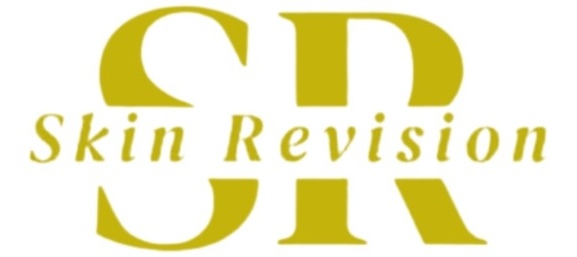Xanthelasma – What is it? How can it be Treated?
Xanthelasma is caused by cholesterol-rich deposits that build up under the skin, leading to the formation of the yellowish lesions. The exact reason for these deposits is not always clear, but it is often associated with lipid metabolism disorders. People with high cholesterol levels, especially high levels of low-density lipoprotein (LDL, or “bad” cholesterol), are more likely to develop Xanthelasma. However, even people with normal cholesterol levels can sometimes develop this condition, so there isn’t always a direct link between Xanthelasma and high cholesterol.
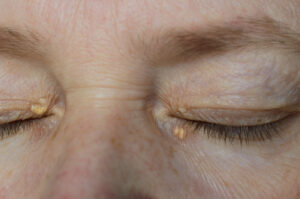
The skin condition / blemishes known as Xanthelasma, are generally plaques that are yellow in colour and appear between the nose and the eyes as well as around the eyelids. Whilst they are harmless, this skin condition can be cosmetically distressing and may indicate the underlying health concerns mentioned.
Symptoms of Xanthelasma
The most noticeable symptom of Xanthelasma is the presence of yellowish or whitish plaques on the skin around the eyes. These plaques are typically:
- Flat or slightly raised: Xanthelasma lesions are usually soft and may feel slightly elevated from the surface of the skin.
- Yellowish in colour: The yellow colour is due to the presence of cholesterol and other lipids in the plaques.
- Located around the eyes: Xanthelasma most commonly appears on the upper or lower eyelids, but it can occasionally form in other areas around the eyes, such as between the nose and the eyes.
- Non-painful: Xanthelasma is typically painless and does not cause itching, irritation, or other discomfort. However, its appearance can be cosmetically concerning for many individuals.
At Skin Revision, we provide an advanced treatment to reduce the appearance of Xanthelasma and restore smooth, healthy skin. In this article, here we’ll cover what Xanthelasma is, its causes, and the non-invasive treatment available to manage and treat this condition.
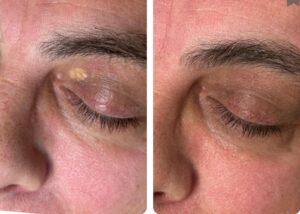
What is Xanthelasma?
Xanthelasma is considered a type of Xanthoma, which is a condition where fatty growths form in certain areas of the skin, due to an accumulation of cholesterol or other lipids.
While Xanthelasma itself is not harmful or painful, it can affect the appearance of the skin around the eyes, leading individuals to seek treatment for cosmetic reasons. In many countries, including the UK, non-surgical treatments for Xanthelasma, cannot be carried out through the NHS or doctor / GP. Treating Xanthelasma is deemed a cosmetic treatment and therefore the costs cannot be made by the NHS. Skin Clinics such as Skin Revision in Beaconsfield, safely treat Xanthelasma every week, and as such, are recognised as a preferred place for this treatment.
What causes Xanthelasma?
- High Cholesterol
One of the most common causes of Xanthelasma is elevated cholesterol levels, particularly low-density lipoprotein (LDL), often referred to as “bad cholesterol.” When cholesterol levels are too high, fatty deposits can accumulate in different parts of the body, including the skin around the eyes.
- Genetics
Genetics play a significant role in whether someone will develop Xanthelasma. Some individuals may be genetically predisposed to lipid disorders, even if their cholesterol levels are within a normal range. In these cases, Xanthelasma may develop regardless of lifestyle factors.
- Lipid Disorders
In some cases, Xanthelasma may be linked to lipid disorders, such as familial hypercholesterolemia, a genetic condition that results in very high cholesterol levels. Lipid imbalances, including increased levels of triglycerides, can also contribute to the formation of Xanthelasma.
- Age and Gender
Xanthelasma most commonly appears in middle-aged or older adults, and it tends to affect women more often than men. While it can occur in younger individuals, it is more likely to develop as people age, especially if they have other risk factors like high cholesterol.
- Health Conditions
Certain medical conditions, such as diabetes, hypothyroidism, and liver disease, can increase the likelihood of developing Xanthelasma. These conditions can affect cholesterol metabolism or cause lipid imbalances, leading to the formation of fatty deposits in the skin.
Xanthelasma typically does not affect vision or cause physical discomfort. However, it can grow larger over time, and in some cases, individuals may develop multiple plaques around both eyes.
Xanthelasma on Asian and Indian Skin
Studies have found that people of Asian, Indian and Mediterranean descent may be more prone to Xanthelasma. In Asian individuals, it may appear more frequently and be more noticeable due to the distinctive skin tone contrast.
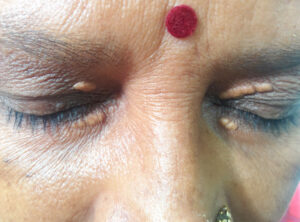
Effective treatments for Xanthelasma
At Skin Revision we offer CryoPen, an advanced, non-invasive treatment to reduce the appearance of Xanthelasma, improving skin texture and restoring a more even-toned complexion.
What is CryoPen Treatment?
CryoPen treatment is a form of cryotherapy that uses extreme cold to remove unwanted skin lesions. The CryoPen device delivers a precise, high-pressure jet of nitrous oxide (N2O) directly to the targeted area, freezing and destroying the abnormal tissue of the Xanthelasma. This method is both safe and effective, making it a popular choice for treating a variety of skin conditions such as Warts, Verrucas, Skin Tags and Seborrheic Keratosis, at clinics such as Skin Revision.
How Does CryoPen Treatment Work?
The CryoPen works by utilising the principles of cryotherapy, which involves the application of extreme cold to freeze and destroy unwanted tissue. Here’s a step-by-step overview of how the CryoPen treatment process works:
- Consultation and Assessment: The first step involves a thorough consultation over the phone with the skin experts at Skin Revision. A photo is often asked for via Whats App, as a helpful addition to the free consultation phone call. During this consultation, the Skin expert will be able to ascertain whether the lesion is Xanthelasma, will discuss the forthcoming treatment and give an indication of the price.
- Preparation: Before the treatment begins, the area is cleaned and prepped. This ensures that the CryoPen device can be applied accurately and effectively.
- Application of CryoPen: The CryoPen device is then used to deliver a controlled and precise jet of nitrous oxide to the targeted area. The high-pressure jet instantly freezes the target, causing the cells to crystallise and eventually die.
- Post-Treatment Care: After the treatment, the area may appear white and then red as it thaws. Over the next few days or weeks, the frozen lesion will form a scab and eventually fall off, revealing healthy new skin beneath.
- Further Treatment: It is likely that a seond or even a third treatment may well be necessary in order to remove any last remains of the Xanthelasma.
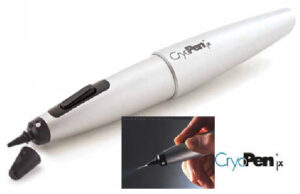
Benefits of CryoPen Treatment
CryoPen treatment offers numerous benefits, making it a preferred choice for many patients seeking to remove unwanted skin lesions. Some of the key benefits include:
- Precision The CryoPen device allows for highly precise targeting of the area, ensuring that only the abnormal tissue is affected while the surrounding healthy skin remains intact.
- Minimal Discomfort CryoPen treatment is minimally invasive and generally well-tolerated by patients. The freezing process may cause a slight stinging sensation, but it is typically brief and manageable.
- Quick Procedure CryoPen treatment is a quick procedure that can be completed in a single session. Depending on the size of the treatment area, the process can take just a few minutes. It is important to note that more than one treatment may well be required for a number of skin lesions, including Xanthelasma.
- No Downtime One of the significant advantages of CryoPen treatment is that there is no downtime required. Patients can return to their normal activities immediately after the procedure.
- Effective Results CryoPen treatment is highly effective in removing various skin lesions. Most patients see noticeable improvement within a few days to weeks after the treatment.
- Low Risk of Scarring Because CryoPen treatment is precise and non-invasive, there is a low risk of scarring. The treated area typically heals well, with minimal risk of infection or complications.
- Versatility CryoPen treatment can be used on a wide range of skin conditions, making it a versatile option for patients with multiple types of lesions.
- Safe for All Skin Types CryoPen treatment is safe for all skin types and can be used on both adults and children, making it a suitable option for patients of all ages.
Aftercare and Recovery
Following CryoPen treatment, it is important to follow the aftercare instructions provided by your skincare professional to ensure optimal healing and results. Some general aftercare tips include:
- Keep the Area Clean: Gently clean the treated area with mild soap and water to prevent infection.
- Avoid Picking or Scratching: Allow the treated lesion to heal naturally and avoid picking or scratching at the scab.
- Protect from Sun Exposure: Use sunscreen and avoid direct sun exposure to prevent hyperpigmentation and promote healing.
- Follow Up: Attend any follow-up appointments as recommended to monitor the healing process, further treat if necessary and address any concerns.
CryoPen treatment is an innovative and effective solution for removing various skin lesions. At Skin Revision, we are dedicated to providing our patients with the best possible care and treatments to improve their skin health and confidence.

Lifestyle Changes and Medical Management
In some cases, treating the underlying cause of Xanthelasma, such as high cholesterol or a lipid disorder, can help prevent the formation of new plaques or slow the progression of existing ones. Lifestyle changes—such as adopting a healthy diet, exercising regularly, and managing cholesterol levels—can help reduce the risk of Xanthelasma returning after treatment.
If you have high cholesterol or a related condition, working with your healthcare provider to manage your lipid levels through diet, exercise, and possibly medication is crucial. This medical management can complement cosmetic treatments for Xanthelasma, ensuring long-lasting results.
Preventing Xanthelasma
While Xanthelasma cannot always be prevented, certain steps can help reduce your risk:
- Monitor cholesterol levels: Regular cholesterol checks with your GP can help you keep your lipid levels under control.
- Adopt a heart-healthy diet: A diet rich in fruits, vegetables, whole grains, and healthy fats (such as omega-3 fatty acids) can help manage cholesterol levels.
- Exercise regularly: Regular physical activity can help lower LDL cholesterol and raise HDL cholesterol (the “good” cholesterol).
- Avoid smoking: Smoking can increase cholesterol levels and affect overall heart health, contributing to Xanthelasma formation.
At Skin Revision, we’re committed to helping you achieve your skincare goals with the latest treatment options. If you’re concerned about Xanthelasma and want to explore your treatment option, contact us today to schedule a free phone call consultation and take the first step toward clearer, smoother skin.
